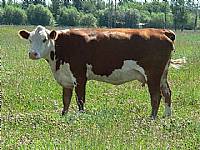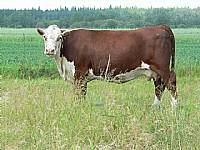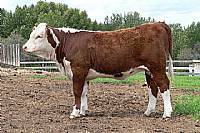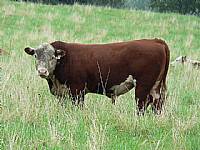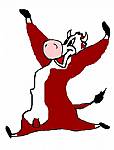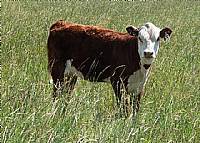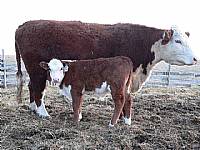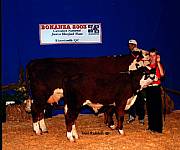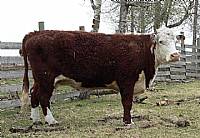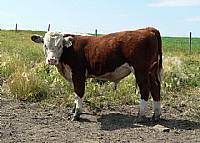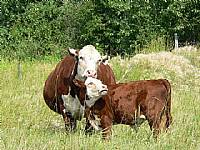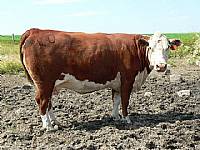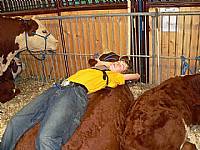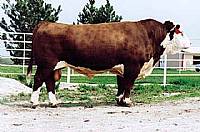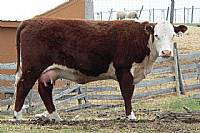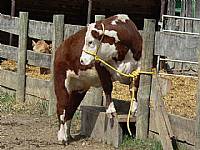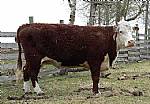
|
|
Polled Hereford page
Our Polled Hereford herd was basically started in 1991 with the acquisition of some cows from my father, Ivor Lyster. He had raised Polled Herefords for over 20 years at the time. Other herd additions came from mostly dispersal sales and breeders in the Ashmont and Two Hills areas. The use of artificial insemination was a major factor in the genetics of our herd. The use of some very popular bulls from well known operations led to some concerns that we were not heading where we wanted to go. At this time I began looking into other bloodlines than those that were popular with the show ring. Through my search for balanced trait cattle, I kept coming across Victor based cattle. I then tried a couple of different bulls through A.I., with the results being very acceptable to the commercial customer. We had found an answer to some of their most common complaints about Herefords and Polled Herefords. We were able to get lighter birth weights while still having reasonable growth and at the same time have genetics that could yield a moderate sized cow with a good udder and teats. A bonus was that we were able to also find sires that would help marbling in their market cattle. We had come to the conclusion that selection for growth was not as important as the selection for optimum performance for a given environment and more importantly the selection for optimum profitability was most important. This meant selecting for convenience traits was necessary to reduce labor while balancing growth, maternal and carcass traits. This is an ongoing progress but we feel our genetics are better suited to the commercial man’s needs now. The quest for balanced trait sires led to a unique find, RHF IGT Victor 103T. At the time I found him, he was an aged bull with numerous daughters in production. His E.P.D.s had a high level of accuracy showing him to be just slightly better than breed average in all but 2 traits. The 2 traits were milk and back fat. His back fat was higher than breed average, not a bad thing when one is looking at it from a cowherd perspective. His milk was not below average but rather substantially above average. Initially it was a concern, as high milking females are not necessarily able to maintain their fertility in less than ideal conditions. Upon more research, it was found that his daughters did definitely milk, from beautiful udders, but also managed to breed back very well as evidenced by daughters 8 years plus still maintaining a 365 day calving interval. Another factor in selecting 103T was his dam, the great RHF Victra 424 654 (perhaps the best Victor cow of all time). Due to some minor setbacks, it was 2000 before we were able to import semen to Canada. While working on importing semen on 103T, we had also imported semen on a son and another Victor bull from 103T’s owner Callier Farms in Missouri. These sires coupled with other Victor influenced sires available through A.I. have become the basis of our herd. A major reduction of the herd occurred in the drought years and rebuilding was set back with BSE. Nevertheless, we have continued to search for genetics to enhance our program. To this end we have purchased females from such good herds as NCX (Dennis and Andrea Babiuk), Brosseau Lake Stock Farm both from Brosseau, Alberta, and Mil Wray Polled Herefords from Tilston, Manitoba. These additions are the basis of Rocky’s herd. He recently added heifers from Double U and Twin View Polled Herefords both from Manitoba, as well as from Rolleyview Polled Herefords from Fawcett, Alberta. Rocky is a proud member of the Canadian Junior Hereford association as well as the Alberta Junior Association. He enjoys showing at the junior shows especially Bonanza (the CJHA national show). Rocky also uses the CJHA semen donation program to try some different genetics and introduce them into his herd. A major contribution to our program has been the find of a great Klondike cow, Klondike June 594B. 594B was discovered in the herd at Dynamite Acres, operated by Dani and Ryan Scott from Olds, Alberta. June herself was not real noticeable in Dani’s herd, but man her daughters sure were. Structure of June and her daughters was good, but more importantly was the job they did on their calves. Convinced that this aged cow could help our program, we negotiated a deal with Dynamite Acres whereby we shared a couple of flushes prior to becoming the owners of June. We have since flushed her again and now have embryos sired by RHF IGT Victor 103T, CMF RF Genetic Phase and KCF Bennett 774 H119. Offspring of all three combinations are on the ground. Dani has excellent bred heifers by 103T and Genetic Phase and we have a bull sired by the Bennett bull. Our move put our embryo program on hold but our hope is to implant a number of embryos next spring. Cattle are registered with the Canadian Hereford Association. Polled Hereford history and information; The Hereford breed was was founded over 250 years ago near Hereford in Herefordshire County, England. The breed was developed to fill the need for a breed of cattle, which could efficiently convert the native grass to beef profitably. This is exactly what Herefords and Polled Herefords still excel at. Benjamin Tomkins is credited with founding the breed and right from the start his goals were economy in feeding, early maturity, and prolificacy. Early Herefords were large with many reaching 3000 pounds and a noted show bull weighing 3900 pounds in 1839. Herefords were first imported into the USA in 1817 with the first notable herd established in 1840. The Hereford became known as the “Great Improver” as they crossed exceptionally well on the common long horned cattle found throughout the western U.S.A.. Demand created a need for more importations in the 1890’s. The Hereford soon became king of the North American beef industry based on their ability to meet the demands of the time. The preferred animal was one that could fatten well on forage and do so readily at an early age (2 to 3 years rather than longer). This quest for being able to fatten earlier and earlier led to the selection for a more compact type. Although at the time, considered ideal, this compact “pony” type was a detriment to the breed. The market for tallow declined and the consumer no longer wanted the excess fat cover. In the 1960’s the change to a type that could gain faster, converting feed to muscle rather than fat was began. The performance era had came. Thankfully there was a broad genetic base and within a few short years major strides had been made. Perhaps this is also the time when some of the convenience traits were overlooked in the quest for performance. The push for performance to compete with the European breeds led to the breed selecting heavily for more frame and mature weight. Not all bad, but perhaps taken to far to the point of losing some of the efficiency of the breed. More recent times has seen a correction of many of the problems which came about with single trait selection. The Hereford is back. Polled Herefords were developed in the 1890’s by some futuristic breeders, that realized they could create Herefords with all the same traits, just minus the horns. Mutations had occasionally produced polled cattle and it is these that Warren Gammon of Des Moines, Iowa sought out to establish the Polled Hereford breed. The Polled Hereford breed officially came into being in 1901 with 11 registrations. In 1907 the pioneer breeders incorporated their organization. For many years the rivalry between Horned and Polled raged on, but in more recent times the 2 breed associations combined. The only real difference was the horn status. The Hereford with its unmistakable white face on a red body with white belly and varying amounts of white on neck and legs was and is an efficient producer of beef from forage. The extremely docile nature also contributes to their efficiency and popularity. The Hereford's greatest asset, being an excellent cross with almost every breed, is also one of its biggest liabilities. Most everyone likes the “baldy” cattle but always refers to them by the other breed when noting the cross. What would be the effect if they were all called Hereford cross? Yes, traditionally the sire breed denoted the naming of the cross but that began when the vast majority of beef cows were Hereford. So please don’t forget where that white face and all its goodness comes from. RHF IGT VICTOR 103T
JAN 10, 1985
POLLED HEREFORD
(PC02787045)
SEMEN
Contact us for pricing
SEMEN AVAILABLE IN CANADA FROM COYOTE ACRES. U.S.A. SEMEN AVAILABLE FROM CALLIER FARMS IN MISSOURI OR REED ENTERPRISES. 103T IS A GREAT SIRE OF PRODUCTIVE FEMALES WITH LONGEVITY. HE IS A MATERNAL MASTER WITH GROWTH AND CARCASS TRAITS THAT ARE STILL QUITE ACCEPTABLE, BEING CLOSE TO BREED AVERAGE. HIS DAUGHTERS MILK WELL WITH BEAUTIFUL UDDERS AND SMALL TEATS. HE ALSO SIRES A LOT OF PIGMENT WITH MANY OFFSPRING HAVING FRECKLED FACES (AS THEY GET OLDER) AND PIGMENT ON THEIR UDDERS. IF YOU ARE LOOKING AT BUILDING A FUNCTIONAL COW HERD, RHF IGT VICTOR 103T IS A SIRE THAT WARRANTS YOUR CONSIDERATION.
KLONDIKE JUNE 594B
FEB 7, 1992
POLLED HEREFORD
EMBRYOS
Contact us for pricing
EMBRYOS AVAILABLE FROM KLONDIKE JUNE 594B (PC02509464) 2007 EPDS
A) SIRED BY RHF IGT VICTOR 103T (PC02787045) 2007 EPDS
B) SIRED BY KCF BENNETT 774 H119 (PC02837343) 2007 EPDS
C) SIRED CMF RF GENETIC PHASE (PC02837345) 2007 EPDS
|
||||||||||||||||||||||||||||||||||||||||||||||||||||||||||||||||||||||||||||||||||||||||||||||||||||||||||||||||||||||||||||||||||||||||



